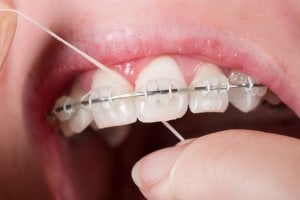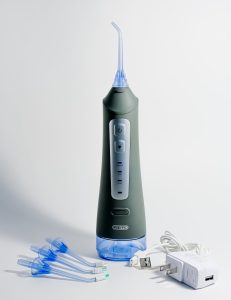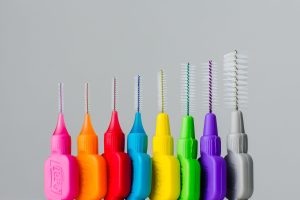Have you just had orthodontic work done and are wondering: how do you floss with braces? Flossing with braces can be a pain, but oral hygiene is more important than ever during orthodontic treatment. Braces provide lots of hiding places for bacteria, so you need to do a thorough job of cleaning them.
Fortunately, with the right products and technique, you can soon master the art of cleaning properly between each tooth. Keep reading for our tips to make the process a bit easier.
In This Article
Why is flossing with braces important?
Our teeth are under constant attack from acid and bacteria in the food and drink we consume. Brushing twice a day and flossing daily, whether you should floss before or after brushing, is usually enough to keep teeth healthy.
However, braces create more surfaces for bacteria to cling to and more holes for food to get stuck in. They also make your normal teeth-cleaning routine more time-consuming. If you don't make the extra effort to maintain good oral hygiene, you're at risk of getting:
- Bad breath
- Yellow or stained teeth
- White spots on teeth
- Tooth decay
- Gum disease
Once your teeth are properly aligned you should find it easier to keep your teeth clean. But while you're fixing the issue of your crooked teeth, make sure you're not creating even more problems for yourself.


How do you floss your teeth with braces?
The thing that prevents you from flossing the traditional way is the archwire – the wire that runs through each brace bracket to connect them all together. Dental floss gets stuck halfway down, so you need to thread the floss through each gap below the wire, too.
And that's really the only difference. But even though it's very simple, it makes flossing a lot more complicated.
Helping children floss
Younger brace wearers may not have the dexterity – or the patience – to floss properly under their braces every day, so they need adult help. Many parents find the best way to floss the teeth of children with braces is while they are watching TV because their head stays quite still. Make sure the area is well lit so you can see what you're doing.
Older children and teenagers shouldn't need any help cleaning teeth with braces once they've got the hang of it. However, it's best for parents to supervise them now and again to make sure they're doing it properly.
Flossing products for people with braces
Dental floss is available waxed or unwaxed and as single-strand (monofilament) or multi-strand (multifilament). You'll find that waxed monofilament is the best floss for braces, as it glides more easily around your braces and is less likely to snag or get stuck.
Now, it's certainly possible to carefully thread dental floss under braces, and you can get the job done just fine. However, with either type it can be frustrating and very time-consuming. Not to mention the fact that it gets more difficult as you floss farther back in the mouth.
We find that a great way to make flossing easier with or without braces is using a water flosser. These devices are similar to ones used by dentists to remove plaque along the gum line, without being as harmful as regular floss. With all sorts of models available, they are becoming increasingly popular.
But let's not get ahead of ourselves. We'll go into more detail on water flossers, but there are lots of products specifically designed to make the job of flossing with braces a lot easier. So let's take a look.
Floss threaders for braces


Trying to thread the flimsy floss through each hole can be pretty annoying and frustrating. Instead, you might choose to use an orthodontic floss threader to make the job easier. These needle-shaped devices have a stiffer point which makes it quicker and easier to get the floss into position.
There are lots of brands which make this product, and we highly recommend GUM EEZ-Thru floss threaders for braces. They are made of flexible nylon, and come in a convenient and hygienic carrying case which is useful for travel, or keeping them in a backpack for students who want to floss after lunch.
It's easy to learn how to use a floss threader. Simply run the tail and part of the loop below the arch wire. Once the loop has passed about half way, thread in a few inches of floss and pull the loop the rest of the way through. Then you are ready to clean between your teeth as normal, pull the floss through and repeat the process.
Watch the video below for a visual example of how to use a floss threader:
Because they work for any type of floss, threaders are probably the least complicated way to adapt your oral hygiene routine to braces. They don't require you to continuously buy picks or special flosses. However, their main drawback is that flossing each gap is a process in itself, and can still feel like a lot of trouble.
Orthodontic floss for braces


If you don't like the idea of using an entirely different tool for threading floss under your arch wires, there's a slightly faster solution. You can buy dental floss for braces which is designed especially for use with orthodontic appliances.
Oral B's Superfloss, for example, has the following features:
- Pre-cut strands
- One stiff end for easy threading under braces
- Part regular waxed floss
- Part thicker, spongy floss for easier cleaning of orthodontic appliances
One Amazon reviewer found that this was a great help:
“Recently got braces fitted and was spending way too long messing around with regular floss. Grabbed some of these and it makes the job much easier…”
The advantage of orthodontic floss over threaders is that you save a second or two per tooth by not having to repeat the process of inserting the threader, threading floss, pulling through and flossing. It may not seem like much, but someone with 32 adult teeth could see the length of their routine cut in half by eliminating just that one step.
Floss picks for braces


Another more convenient option for people with braces is to use floss picks. These are forked pieces of plastic with a length of floss attached which allow you to floss one-handed. There are lots of these on the market for regular flossing, but not all of them are suitable for people with braces.
Platypus has designed orthodontic flossers specifically for braces, and they have become very popular. They are similar to regular floss picks, but one part of the fork is thinner so it fits between the archwire and your teeth. This allows you to quickly get floss in between your teeth without having to thread through any gaps.
Beyond that, the Platypus orthodontic flosser has a bracket brush on the end of the handle. This part is specialized for cleaning food particles off of the brackets themselves, offering an all-in-one cleaning tool for your braces.
Although orthodontic flossers like Platypus are a very quick and easy way to floss with braces, they do have a notable drawback. They are made of substantially more plastic than floss and are meant to be thrown away after each use. So, those who are concerned about how much plastic they consume will most likely prefer a different option.
And, in fact, there is a flossing solution which doesn't involve anything disposable at all.
Using a water flosser


If you or your child find it too difficult to use normal dental floss with braces, another option is an electric water flosser. Also called oral irrigators, these devices look a bit like electric toothbrushes but they emit a pressurized jet or pulse of water (and air, with some models) to clean between teeth.
There are lots of popular brands of water flosser for braces include cariPRO, Waterpik, Jetpik and Philips Airfloss. These are available in a number of different models with various features. Look for one with an adjustable power setting, especially if you'll be using it on your children's teeth.
You can also opt for one that comes with a toothbrush as well, like the Waterpik Complete Care.
In the world of oral irrigators, you probably won't find better than the cariPRO Cordless Water Flosser. This water flosser has a large 155ml reservoir for 45 seconds of continuous flossing. There are also three floss modes — normal, soft, and pulse, so you can customize water flow depending on who is flossing.
The cariPRO also comes with (among others) an orthodontic tip for flossing with braces.
This short animation shows how a water flosser can make the job of cleaning teeth with braces much easier:
Officially, the jury is out on whether an oral irrigator is good enough to use in place of regular floss since it doesn't have the same physical contact to scrape plaque off teeth. However, some studies have shown that water flossers are actually more effective than string floss. It's also certainly something to consider to reduce plastic waste in your routine.
Air flossers are another alternative that work in a similar fashion. Read more about water flossers vas air flossers here.
If you think a water flosser would help improve your flossing with or without braces, read our comparison guide of the best water flossers to learn more about the options that are available.
Using an interdental brush


Again, if regular floss is too difficult to use, and if a water flosser doesn't appeal to you, you may want to try using an interdental brush. Interdental brushes look sort of like mini bottle cleaners—they've got a small handle and then a wire with bristles radiating out from it. Many dentists consider interdental brushes, when used once a day, an adequate or better substitute for flossing.
These little brushes can also be very handy for picking bits of food out of your braces after eating.
There are several varieties of interdental brush. One of the most popular brands is Tepe. They offer a wide range to choose from, but a good place to start is with their original interdental brush. These brushes come in various widths, and they feature a wire brush coated in softer plastic for gentle flossing as well as a flexible neck for easy cleaning.
You can also check out Dentek disposable interdental brushes with reusable handles with disposable tips. There are also special interdental heads for electric toothbrushes, which are certainly worth considering if you already have the base handle.
For a more in-depth explanation and comparison between the different types available, you can read more in our interdental brush guide.
Conclusion
Understanding how to floss teeth with braces isn't that complicated, but it can be a serious hassle to do properly every day. Using regular floss you can do a perfectly adequate job, but threading it in and out of the space below the arch wire makes the task a lot more frustrating and time-consuming.
Thankfully there are lots of different products that help make flossing easier. These include:
- Floss threaders
- Partially rigid dental floss for braces
- Specially designed floss picks
- Water flossers with tips for braces
- Interdental brushes
Any of them are a great way to floss with braces, and the best one for you will depend on your preferences regarding cost, convenience and reusability. You might find that the most effective solution for you is a combination of two or three of these tools.
Ultimately, if the hassle of threading floss between your braces means you just don't bother, you might better switch to a water flosser or an interdental brush instead. These methods of flossing for braces are certainly better than not doing it at all, and indeed, in the case of interdental brushes can be just as good or better.
Here's table comparing the pros and cons of different products for flossing with braces:
Product | Image | Pros | Cons | Cost |
Floss threader (GUM) | Uses regular floss, low price | Requires two hands, not much faster | ||
Orthodontic floss (Oral-B) | Faster than using a threader, comes in pre-cut strands | Requires two hands, single use | ||
Orthodontic floss picks (Platypus) | One-handed flossing, some come with bracket brushes | Disposability means more plastic waste | ||
Oral irrigator (CariPRO) | No plastic waste, can use one-handed | Higher price, needs power source | ||
Interdental brush (Tepe) | Very effective, possibly better than normal flossing | Disposables lead to plastic waste, electrics are more expensive |
FAQs
With braces, should I floss first or brush first?
Flossing is meant to clean between your teeth and brushing is for the surface, and dentists don't always agree on which to do first. Either way is ok, as long as you floss once a day! Some prefer to floss first, so food and plaque that are dislodged from flossing will be cleaned away when you brush. Others prefer to do it in reverse order to remove as much plaque as possible from the surface before going in for the deep clean.
What happens if you don't floss while you have braces?
It's just as important to floss when you have braces as when you don't. By not flossing, you allow bacteria-filled plaque to accumulate between your teeth along the gum line. Eventually this can cause problems like bad breath and eventually periodontitis.
How many times a day should you floss with braces?
With braces you should probably increase your brushing to once after every meal, but it's okay if you still floss only once a day. Plaque buildup between teeth won't change much due to braces.









